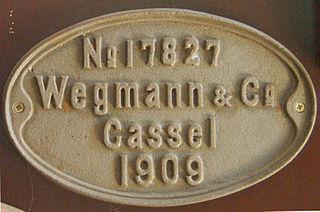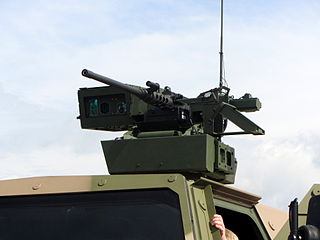
The Leopard 2 is a third generation German main battle tank (MBT). Developed by Krauss-Maffei in the 1970s, the tank entered service in 1979 and replaced the earlier Leopard 1 as the main battle tank of the West German army. Various iterations of the Leopard 2 continue to be operated by the armed forces of Germany, as well as 13 other European countries, and several non-European countries, including Canada, Chile, Indonesia, and Singapore. Some operating countries have licensed the Leopard 2 design for local production and domestic development.

The Boxer is a multirole armoured fighting vehicle designed by an international consortium to accomplish a number of operations through the use of installable mission modules. The governments participating in the Boxer programme have changed as the programme has developed. The Boxer vehicle is produced by the ARTEC GmbH industrial group, and the programme is being managed by OCCAR. ARTEC GmbH is based in Munich; its parent companies are Krauss-Maffei Wegmann GmbH and Rheinmetall Military Vehicles GmbH on the German side, and Rheinmetall Defence Nederland B.V. for the Netherlands. Overall, Rheinmetall has a 64% stake in the joint venture.

The Mamba is a South African armoured personnel carrier designed for internal security purposes. It was developed during the late 1980s to replace the Buffel in service with the South African military and security forces. The first models were built on a 4X2 Toyota Dyna chassis, which was subsequently replaced in production around 1994 by a more reliable Unimog chassis. All marks of the Mamba were designed to be mine-resistant and blastproof.

The Panzerhaubitze 2000, meaning "armoured howitzer 2000" and abbreviated PzH 2000, is a German 155 mm self-propelled howitzer developed by Krauss-Maffei Wegmann (KMW) and Rheinmetall in the 1980s and 1990s for the German Army. The PzH 2000 has automatic support for up to five rounds of multiple round simultaneous impact. Replenishment of shells is automated. Two operators can load 60 shells and propelling charges in less than 12 minutes. The PzH 2000 equips the armies of Germany, Italy, Ukraine, Netherlands, Greece, Lithuania, Hungary, Qatar and Croatia, mostly replacing older systems such as the M109 howitzer. In November 2019, a PzH 2000 L52 gun fired a shell a distance of almost 67 km (42 mi). As of 2020, a prototype L52 gun with a new charge is being tested for a range of at least 75 km (47 mi).

Hellenic Vehicle Industry is a Greek vehicle manufacturer based in Thessaloniki.

The Puma is a German infantry fighting vehicle (IFV) designed to replace the aging Marder IFVs currently in service with the German Army. Production of the first batch of 350 vehicles began in 2010 and was completed in August 2021. A second batch of 229 Pumas received funding. Mass production began on 6 July 2009. The companies responsible for this project are Krauss-Maffei Wegmann and Rheinmetall Landsysteme, which created a joint venture, Projekt System Management GmbH (PSM). The Puma is one of the world's best-protected IFVs, while still having a high power-to-weight ratio.

The Fennek, named after the fennec, or LGS Fennek, with LGS being short for Leichter Gepanzerter Spähwagen in German, is a four-wheeled armed reconnaissance vehicle produced by the German company Krauss-Maffei Wegmann and Dutch Defence Vehicle Systems. The Turkish company FNSS Defence Systems acquired the right for licence production in 2004. It was developed for both the German Army and Royal Netherlands Army to replace their current vehicles.

An infantry mobility vehicle (IMV) is a wheeled armored personnel carrier (APC) serving as a military patrol, reconnaissance or security vehicle. Examples include the ATF Dingo, Iveco LMV, Oshkosh M-ATV, AMZ Dzik, AMZ Tur, Mungo ESK, and Bushmaster IMV. This term also applies to those vehicles fielded as part of the MRAP program.

The Mungo ESK is an air-transportable, armoured multirole transport vehicle operated by the Airmobile Operations Division and the Rapid Forces Division of the German Army.

The International M1224 MaxxPro MRAP is an armored fighting vehicle designed by American company Navistar International's subsidiary Navistar Defense along with the Israeli Plasan Sasa, who designed and manufactures the vehicle's armor. The vehicle was designed to take part in the US military's Mine Resistant Ambush Protected vehicle program, led by the US Marine Corps, as well as a similar US Army-led Medium Mine Protected Vehicle program.

The GFF4, previously KMW Grizzly, is a medium weight MRAP armored personnel carrier, developed by Krauss-Maffei Wegmann (KMW), designed for operation with the German Army based on the 6x6 Trakker chassis from Iveco adapted to meet the needs of the German Army. It is being developed under the direction of the German Ministry of Defence Federal Office of Defense Technology and Procurement. The GFF4 is designed to meet the German Army's "Class 4" protected command and role-specific vehicles, with a gross vehicle weight of 25 tons, and transportable on the Airbus A400M aircraft. Currently, the German Army could use only the smaller 12.5 ton ATF Dingo 2 or the 33 ton Boxer MRAV.

Krauss-Maffei Wegmann GmbH & Co. KG (KMW) is an arms industry company based in Munich, Germany. The company produces various types of equipment as well as tanks, self-propelled artillery, and other armoured vehicles.

The Artillery Gun Module is an air-portable 155 mm self-propelled howitzer designed by Krauss-Maffei Wegmann. It is based on technology used in the German Army Panzerhaubitze 2000 system, to provide more air portable self-propelled artillery, transportable by Airbus A400 aircraft.

Ashok Leyland Defence Systems is a Hinduja Group company involved in manufacturing military trucks such as the widely used Stallion troop carriers.

The form coach factory of Wegmann & Co. was founded in 1882 in Kassel by Kommerzienrat, Peter Wegmann, and Richard Harkort as the Casseler Waggonfabriken von Wegmann, Harkort & Co. In 1886 it changed its name to Wegmann & Co.

The KMW+Nexter Defense Systems (KNDS) is a European defence industry holding company, which is the result of a merger between Krauss-Maffei Wegmann and Nexter Systems. The joint holding company is headquartered in Amsterdam, Netherlands.

The HX family are a range of purpose-designed tactical military trucks manufactured by Rheinmetall MAN Military Vehicles (RMMV). The HX range was disclosed in 2003, and the first order was placed in 2004. The HX range replaced the earlier FX and LX ranges in production. The HX2 range, which currently complements the original HX range, was announced in 2012. The first HX2 range trucks were delivered in April 2016. The HX and HX2 ranges originally complemented the SX range, but as of 2019 they had replaced the SX range as the type was no longer produced. The HX3 range was announced in May 2021, with series production scheduled for 2024.

The Armoured Multi Purpose Vehicle (AMPV) is a well-protected light armoured 4×4 vehicle that has been developed as a joint venture between Germany's Rheinmetall MAN Military Vehicles (RMMV) and Krauss-Maffei Wegmann (KMW). It was developed for the German Army's Protected Command and Function (GFF) Group 2 requirement.

FLW stands for "remotely operated, light weapon station" developed by the German defence company Krauss-Maffei Wegmann brands its family of remote weapon stations.
The Main Ground Combat System (MGCS) is a project launched in 2017 by Germany and France, aiming to replace their current Leopard 2 and Leclerc main battle tanks. Coordinated by Germany, in contrast to the other major Franco-German program launched in 2018, the MGCS will not be a single armoured fighting vehicle but a series of systems conceived around said vehicle.



























